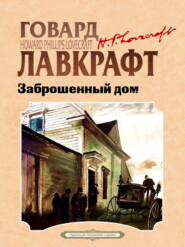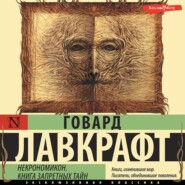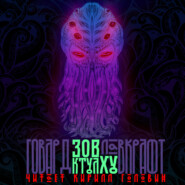По всем вопросам обращайтесь на: info@litportal.ru
(©) 2003-2024.
✖
The Haunter Of The Dark
Настройки чтения
Размер шрифта
Высота строк
Поля
H. P. Lovecraft
The story takes place in Providence, Rhode Island and revolves around the Church of Starry Wisdom. The cult uses an ancient artifact known as the Shining Trapezohedron to summon a terrible being from the depths of time and space.
The Haunter Of The Dark
by H. P. Lovecraft
The Haunter Of The Dark
(Dedicated to Robert Bloch)
I have seen the dark universe yawning
Where the black planets roll without aim,
Where they roll in their horror unheeded,
Without knowledge or lustre or name.
– Nemesis
Cautious investigators will hesitate to challenge the common belief that Robert Blake was killed by lightning, or by some profound nervous shock derived from an electrical discharge. It is true that the window he faced was unbroken, but nature has shown herself capable of many freakish performances. The expression on his face may easily have arisen from some obscure muscular source unrelated to anything he saw, while the entries in his diary are clearly the result of a fantastic imagination aroused by certain local superstitions and by certain old matters he had uncovered. As for the anomalous conditions at the deserted church of Federal Hill – the shrewd analyst is not slow in attributing them to some charlatanry, conscious or unconscious, with at least some of which Blake was secretly connected.
For after all, the victim was a writer and painter wholly devoted to the field of myth, dream, terror, and superstition, and avid in his quest for scenes and effects of a bizarre, spectral sort. His earlier stay in the city – a visit to a strange old man as deeply given to occult and forbidden lore as he – had ended amidst death and flame, and it must have been some morbid instinct which drew him back from his home in Milwaukee. He may have known of the old stories despite his statements to the contrary in the diary, and his death may have nipped in the bud some stupendous hoax destined to have a literary reflection.
Among those, however, who have examined and correlated all this evidence, there remain several who cling to less rational and commonplace theories. They are inclined to take much of Blake’s diary at its face value, and point significantly to certain facts such as the undoubted genuineness of the old church record, the verified existence of the disliked and unorthodox Starry Wisdom sect prior to 1877, the recorded disappearance of an inquisitive reporter named Edwin M. Lillibridge in 1893, and – above all – the look of monstrous, transfiguring fear on the face of the young writer when he died. It was one of these believers who, moved to fanatical extremes, threw into the bay the curiously angled stone and its strangely adorned metal box found in the old church steeple – the black windowless steeple, and not the tower where Blake’s diary said those things originally were. Though widely censured both officially and unofficially, this man – a reputable physician with a taste for odd folklore – averred that he had rid the earth of something too dangerous to rest upon it.
Between these two schools of opinion the reader must judge for himself. The papers have given the tangible details from a sceptical angle, leaving for others the drawing of the picture as Robert Blake saw it – or thought he saw it – or pretended to see it. Now studying the diary closely, dispassionately, and at leisure, let us summarize the dark chain of events from the expressed point of view of their chief actor.
Young Blake returned to Providence in the winter of 1934-5, taking the upper floor of a venerable dwelling in a grassy court off College Street – on the crest of the great eastward hill near the Brown University campus and behind the marble John Hay Library. It was a cosy and fascinating place, in a little garden oasis of village-like antiquity where huge, friendly cats sunned themselves atop a convenient shed. The square Georgian house had a monitor roof, classic doorway with fan carving, small-paned windows, and all the other earmarks of early nineteenth century workmanship. Inside were six-panelled doors, wide floor-boards, a curving colonial staircase, white Adam-period mantels, and a rear set of rooms three steps below the general level.
Blake’s study, a large southwest chamber, overlooked the front garden on one side, while its west windows – before one of which he had his desk – faced off from the brow of the hill and commanded a splendid view of the lower town’s outspread roofs and of the mystical sunsets that flamed behind them. On the far horizon were the open countryside’s purple slopes. Against these, some two miles away, rose the spectral hump of Federal Hill, bristling with huddled roofs and steeples whose remote outlines wavered mysteriously, taking fantastic forms as the smoke of the city swirled up and enmeshed them. Blake had a curious sense that he was looking upon some unknown, ethereal world which might or might not vanish in dream if ever he tried to seek it out and enter it in person.
Having sent home for most of his books, Blake bought some antique furniture suitable for his quarters and settled down to write and paint – living alone, and attending to the simple housework himself. His studio was in a north attic room, where the panes of the monitor roof furnished admirable lighting. During that first winter he produced five of his best-known short stories – The Burrower Beneath, The Stairs in the Crypt, Shaggai, In the Vale of Pnath, and The Feaster from the Stars – and painted seven canvases; studies of nameless, unhuman monsters, and profoundly alien, non-terrestrial landscapes.
At sunset he would often sit at his desk and gaze dreamily off at the outspread west – the dark towers of Memorial Hall just below, the Georgian court-house belfry, the lofty pinnacles of the downtown section, and that shimmering, spire-crowned mound in the distance whose unknown streets and labyrinthine gables so potently provoked his fancy. From his few local aquaintances he learned that the far-off slope was a vast Italian quarter, though most of the houses were remnant of older Yankee and Irish days. Now and then he would train his field-glasses on that spectral, unreachable world beyond the curling smoke; picking out individual roofs and chimneys and steeples, and speculating upon the bizarre and curious mysteries they might house. Even with optical aid Federal Hill seemed somehow alien, half fabulous, and linked to the unreal, intangible marvels of Blake’s own tales and pictures. The feeling would persist long after the hill had faded into the violet, lamp-starred twilight, and the court-house floodlights and the red Industrial Trust beacon had blazed up to make the night grotesque.
Of all the distant objects on Federal Hill, a certain huge, dark church most fascinated Blake. It stood out with especial distinctness at certain hours of the day, and at sunset the great tower and tapering steeple loomed blackly against the flaming sky. It seemed to rest on especially high ground; for the grimy facade, and the obliquely seen north side with sloping roof and the tops of great pointed windows, rose boldly above the tangle of surrounding ridgepoles and chimney-pots. Peculiarly grim and austere, it appeared to be built of stone, stained and weathered with the smoke and storms of a century and more. The style, so far as the glass could show, was that earliest experimental form of Gothic revival which preceded the stately Upjohn period and held over some of the outlines and proportions of the Georgian age. Perhaps it was reared around 1810 or 1815.
As months passed, Blake watched the far-off, forbidding structure with an oddly mounting interest. Since the vast windows were never lighted, he knew that it must be vacant. The longer he watched, the more his imagination worked, till at length he began to fancy curious things. He believed that a vague, singular aura of desolation hovered over the place, so that even the pigeons and swallows shunned its smoky eaves. Around other towers and belfries his glass would reveal great flocks of birds, but here they never rested. At least, that is what he thought and set down in his diary. He pointed the place out to several friends, but none of them had even been on Federal Hill or possessed the faintest notion of what the church was or had been.
In the spring a deep restlessness gripped Blake. He had begun his long-planned novel – based on a supposed survival of the witch-cult in Maine – but was strangely unable to make progress with it. More and more he would sit at his westward window and gaze at the distant hill and the black, frowning steeple shunned by the birds. When the delicate leaves came out on the garden boughs the world was filled with a new beauty, but Blake’s restlessness was merely increased. It was then that he first thought of crossing the city and climbing bodily up that fabulous slope into the smoke-wreathed world of dream.
Late in April, just before the aeon-shadowed Walpurgis time, Blake made his first trip into the unknown. Plodding through the endless downtown streets and the bleak, decayed squares beyond, he came finally upon the ascending avenue of century-worn steps, sagging Doric porches, and blear-paned cupolas which he felt must lead up to the long-known, unreachable world beyond the mists. There were dingy blue-and-white street signs which meant nothing to him, and presently he noted the strange, dark faces of the drifting crowds, and the foreign signs over curious shops in brown, decade-weathered buildings. Nowhere could he find any of the objects he had seen from afar; so that once more he half fancied that the Federal Hill of that distant view was a dream-world never to be trod by living human feet.
Now and then a battered church facade or crumbling spire came in sight, but never the blackened pile that he sought. When he asked a shopkeeper about a great stone church the man smiled and shook his head, though he spoke English freely. As Blake climbed higher, the region seemed stranger and stranger, with bewildering mazes of brooding brown alleys leading eternally off to the south. He crossed two or three broad avenues, and once thought he glimpsed a familiar tower. Again he asked a merchant about the massive church of stone, and this time he could have sworn that the plea of ignorance was feigned. The dark man’s face had a look of fear which he tried to hide, and Blake saw him make a curious sign with his right hand.
Then suddenly a black spire stood out against the cloudy sky on his left, above the tiers of brown roofs lining the tangled southerly alleys. Blake knew at once what it was, and plunged toward it through the squalid, unpaved lanes that climbed from the avenue. Twice he lost his way, but he somehow dared not ask any of the patriarchs or housewives who sat on their doorsteps, or any of the children who shouted and played in the mud of the shadowy lanes.
At last he saw the tower plain against the southwest, and a huge stone bulk rose darkly at the end of an alley. Presently he stood in a wind-swept open square, quaintly cobblestoned, with a high bank wall on the farther side. This was the end of his quest; for upon the wide, iron-railed, weed-grown plateau which the wall supported – a separate, lesser world raised fully six feet above the surrounding streets – there stood a grim, titan bulk whose identity, despite Blake’s new perspective, was beyond dispute.
The vacant church was in a state of great decrepitude. Some of the high stone buttresses had fallen, and several delicate finials lay half lost among the brown, neglected weeds and grasses. The sooty Gothic windows were largely unbroken, though many of the stone mullions were missing. Blake wondered how the obscurely painted panes could have survived so well, in view of the known habits of small boys the world over. The massive doors were intact and tightly closed. Around the top of the bank wall, fully enclosing the grounds, was a rusty iron fence whose gate – at the head of a flight of steps from the square – was visibly padlocked. The path from the gate to the building was completely overgrown. Desolation and decay hung like a pall above the place, and in the birdless eaves and black, ivyless walls Blake felt a touch of the dimly sinister beyond his power to define.
There were very few people in the square, but Blake saw a policeman at the northerly end and approached him with questions about the church. He was a great wholesome Irishman, and it seemed odd that he would do little more than make the sign of the cross and mutter that people never spoke of that building. When Blake pressed him he said very hurriedly that the Italian priest warned everybody against it, vowing that a monstrous evil had once dwelt there and left its mark. He himself had heard dark whispers of it from his father, who recalled certain sounds and rumours from his boyhood.
There had been a bad sect there in the old days – an outlaw sect that called up awful things from some unknown gulf of night. It had taken a good priest to exorcise what had come, though there did be those who said that merely the light could do it. If Father O’Malley were alive there would be many a thing he could tell. But now there was nothing to do but let it alone. It hurt nobody now, and those that owned it were dead or far away. They had run away like rats after the threatening talk in ‘77, when people began to mind the way folks vanished now and then in the neighbourhood. Some day the city would step in and take the property for lack of heirs, but little good would come of anybody’s touching it. Better it be left alone for the years to topple, lest things be stirred that ought to rest forever in their black abyss.

















